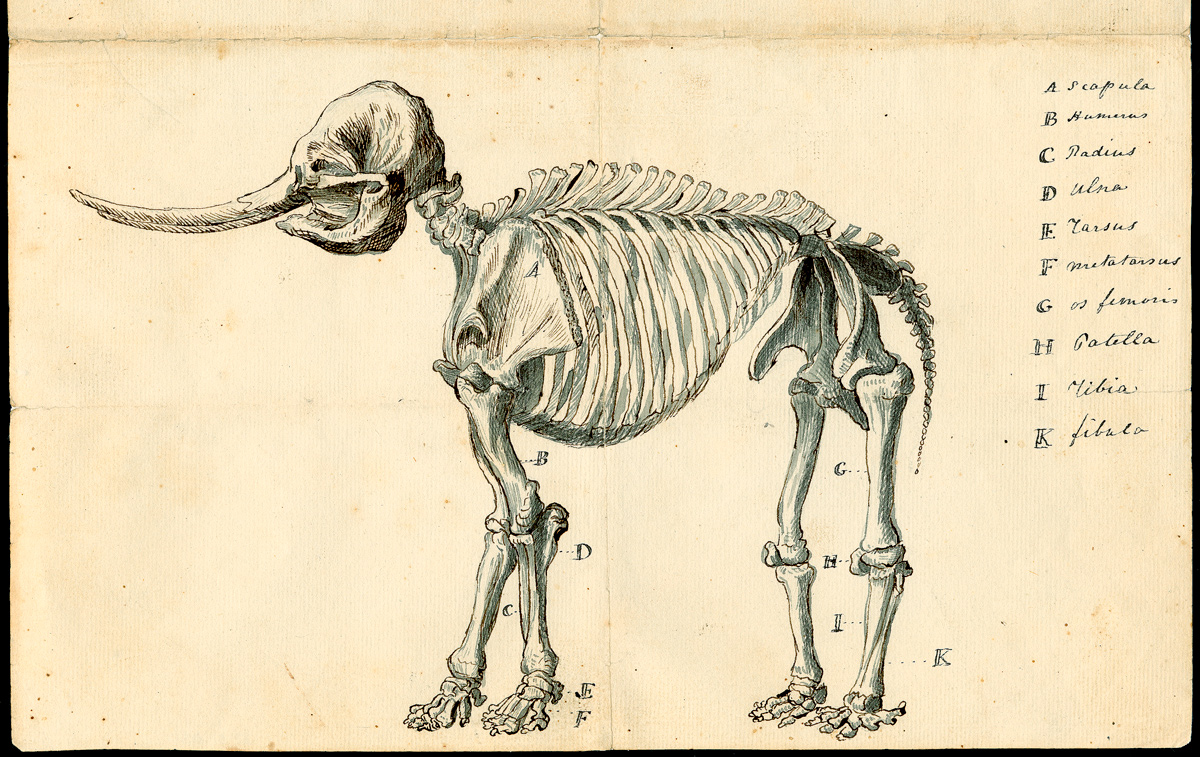Cincinnati, OH Lewis rests his boat crew and works with Dr. Goforth to examine the fossil bones that were excavated from nearby Big Bone Lick. The governor of the Mississippi Territory updates President Thomas Jefferson on the Louisiana Territory.
Bones
Cincinnati, October 3rd 1803.
Dear Sir [Thomas Jefferson],
All the bones, which I observed in the possession of Dr. Goforth appear to be those of the Mammoth, accept only the Elephant-like grin[d]ers; the most remarkable among them was a portion of the lower or larger part of a tusk . . . .
MERIWETHER LEWIS. Capt.
1st. U.S. Regt. Infty.[1]Donald Jackson, ed. Letters of the Lewis and Clark Expedition with Related Documents: 1783-1854, 2nd ed., (Urbana: University of Illinois Press, 1978), 127.
Peale’s Museum Display
Much was already known about the type of fossils extracted from Big Bone Licks. Israel’s 1803 Pittsburgh Almanack provides the following description of the specimen shown in Figure 1:
Naturalist differ as to the specie of the MAMMOTH, but, says an eminent writer, “To whatever Animal we ascribe these remains, it is certain that such an one has existed in America, and that it was the largest of all terrestial beings of which any traces have ever appeared.”
[T]he SKELETON of the MAMMOTH, exhibited to Public view, at New-York, last June, since that time has been taken to Europe, by Mr. Peale, son of Mr. Peale of Philadelphia.
The whole Skeleton weights about 10000 weight.
N.B. Within the breast of the above skeleton Mr. Peale, accompanied by twelve of his friends, partook of a sumptuous dinner.[2]John Israel, The Pittsburgh Almanack, For the Year of our Lord, 1803 . . . (Pittsburgh: Zadok Cramer, Bookseller, 1803), 26.
Claiborne’s Update
Near Natchez
September the 29th 1803Dear Sir,
The Surveyor General Mr Briggs has established his office in the Town of Washington, and added greatly to the happiness of our little society; I hold him in high estimation, and discover with pleasure, that he is acquiring very fast the esteem and confidence of the people. Mr Rodney and Mr Williams have not yet arrived; their appointments as commissioners are very popular, and they are themselves great acquisitions to the Territory.
The form of Government which may be prescribed for our new Territory, excites great anxiety in this quarter. . . . I am inclined to an opinion, that until a knowledge of the American Constitutions, Laws, Language and customs, is more generally diffused, a state Government in Louisiana, would not be managed with descretion.
William C. C. Claiborne[3]“To Thomas Jefferson from William C. C. Claiborne, 29 September 1803,” Founders Online, National Archives, https://founders.archives.gov/documents/Jefferson/01-41-02-0325. [Original … Continue reading
Notes
| ↑1 | Donald Jackson, ed. Letters of the Lewis and Clark Expedition with Related Documents: 1783-1854, 2nd ed., (Urbana: University of Illinois Press, 1978), 127. |
|---|---|
| ↑2 | John Israel, The Pittsburgh Almanack, For the Year of our Lord, 1803 . . . (Pittsburgh: Zadok Cramer, Bookseller, 1803), 26. |
| ↑3 | “To Thomas Jefferson from William C. C. Claiborne, 29 September 1803,” Founders Online, National Archives, https://founders.archives.gov/documents/Jefferson/01-41-02-0325. [Original source: The Papers of Thomas Jefferson, vol. 41, 11 July–15 November 1803, ed. Barbara B. Oberg. Princeton: Princeton University Press, 2014, pp. 427–429.] |

